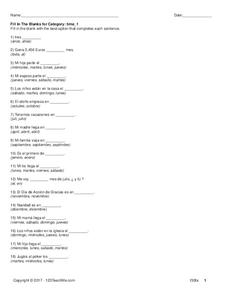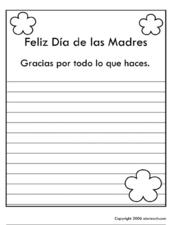Curated OER
Subject Pronouns in Spanish
Here's a great resource to introduce the idea of subject pronouns to your beginning Spanish speakers. First, study the chart provided that details the different subject pronouns. Then, using the chart as reference, complete the short...
Curated OER
Definite and Indefinite Articles
Quiz your beginning Spanish speakers on their use of definite and indefinite articles. Through two short exercises, they review el, la, un, and una. With the first activity, they write the correct Spanish article for each word. In the...
Curated OER
Picture Vocabulary
You might have to get creative to work this practice opportunity into your unit in a meaningful way, but the concept is great for young learners. There are five pictures, and learners recall the Spanish word for each item. Consider...
Curated OER
Matching Vocabulary: Travel
Are you going on a trip, or do you want your beginning speakers to know travel-related vocabulary? Learners review the Spanish meaning for 22 words like bus, trip, first class, and trolley.
Curated OER
Vínculo Entre La Escuela y El Hogar
Give your native Spanish speakers this at-home practice opportunity to reinforce descriptive vocabulary. First they draw their favorite animal, and then they create a short story about their animal. When the assignment is complete, both...
Curated OER
Time
How do we express time in Spanish? Use this activity to assess how well your class knows different words that express time. Most of the 20 sentences look at month vocabulary.
Curated OER
Feliz Día de las Madres
Why is your mom great? Young Spanish speakers of all levels help celebrate Mother's Day by writing their mom a short thank-you paragraph. Decorative writing template included. Consider giving your class some additional prompts to help...
Curated OER
Conmigo y Contigo
How do you know when to use conél, conellas, conellos, con él, etc? Review these terms with your beginning Spanish speakers, and provide them with this practice opportunity. Example sentences are short and direct.
Curated OER
Present Tense: Haber
Review the present tense form of the verb haber with your beginning Spanish speakers. There are 32 questions provided, and pupils must read each sentence to determine which form of the verb best completes the sentence.
Curated OER
Singular Pronouns
Your very beginning Spanish language learners work on matching singular pronouns with the verbs provided. For each of the 32 questions, learners read the sentence and identify which singular pronoun completes the sentence best. A quick,...
Curated OER
El pajarito
Print this online resource for your beginning Spanish speakers. They read the short poem provided and complete the five questions that follow. The questions focus on reading comprehension.
Curated OER
Negation 1
Study a list of negative words (and their counterparts) before distributing this to your class. Words like nada, nadi, ningún, and nunca are included. Your learners read each sentence and select the correct negation from three or four...
Curated OER
Practica de Pronunciación y Ortografía: na, ne, ni, no, and nu
As you read the list of words provided (on the second page), your learners attempt to discern which syllable combinations they heard for each word. They fill each blank with one of the following combinations: na, ne, ni, no, or nu. After...
Curated OER
Diminutives 1
Study how Spanish diminutives are usually formed before giving this practice packet to your intermediate Spanish speakers. For each of 17 sentences provided, your learner must choose the correct option to complete the sentence.
Curated OER
Possessive Pronouns 1
What is a possessive pronoun? After introducing possessive pronouns to your Spanish language learners, provide them with this packet for practice. For each of 27 sentences provided, they must identify the correct possessive pronoun out...
Curated OER
Repaso: U, I, and J Preterite Verbs
Investigate different verbs in the preterite tense with your beginning Spanish speakers. They complete conjugation charts for various verbs like tener, saber, ir, ser, venir, dar, and decir. Verbs are categorized into the following...
Curated OER
Animals and Their Personalities
Now that your young Spanish speakers know the Spanish words for common animals, discuss what each animal eats and their personalities. It's great that the class starts by looking at an animal, identifying a characteristic or trait it...
Curated OER
Animals
Designed for a third grade Spanish class, this mini-instructional activity offers a look at animals and the sounds they make. First, the teacher will review the different sounds that animals make. Then, the whole class will read Miau and...
Curated OER
¿Qué significa el dibjuo? Halloween
What is happening in the picture? Your native-Spanish speakers look at the five pictures and choose the best sentence to describe each. This worksheet has a Halloween theme.
Curated OER
Ser
There is only one question posted here, but consider pairing it with a question that requires some higher-level thinking and present it to your class as a bell-ringer. The pupil simply has to choose the correct word (son, estamos, or...
Curated OER
Barcos de papel
Reading short passages and answering comprehension questions is always a great way to get your beginning Spanish speakers immersed in the language. Here,they read a very short passage about making paper boats and answer four...
Curated OER
Practica de pronunciación y ortografía: ta, te, ti, to, tu
Get your language learners listening carefully as you read a list of 20 words using the syllable combinations ta, te, ti, to, or tu. As you read, pupils record the missing letters for each word. Then, after you finish, the class should...
Curated OER
Practica de pronunciación y ortografía: va, ve, vi, vo, vu
Hone pronunciation skills by introducing your class to the syllable combinations va, ve, vi, vo, and vu. As you read the list of 20 words, pupils record the letters they hear. Then, as a class, pronounce each word aloud.
Curated OER
Personalidad 1
How do you describe others? Read the five sentences provided, and select the description that fits best. Print the document for your learners since there is no way to check your answers if you complete it online.

























